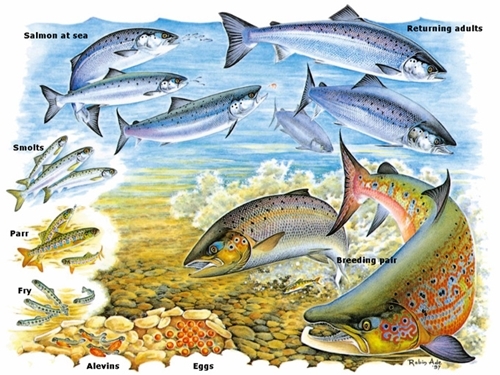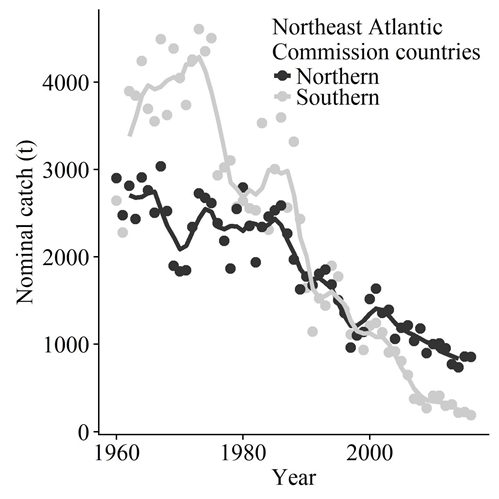Key points
- Declines have been recorded in Atlantic salmon populations recently, which are thought to be because of changes in how well they survive at sea.
- To manage salmon populations better, it is important to understand which factors affect their survival.
- One theory is that larger smolts survive better at sea, so a higher proportion of bigger ones can return to their home river to spawn, compared to smaller ones.
- This study examines how well the published scientific literature supports this theory, and finds that the evidence is not strong.
- This study also suggests a statistical approach to look at fisheries data, which would be better at measuring whether it supports this theory.
Background
Atlantic salmon have a complicated life cycle that involves several stages, which occur in different habitats. They hatch from eggs in freshwater streams and rivers where they grow and develop. They then travel downstream to the ocean, where they go to feed. Finally, they return to their home river to spawn the next generation. They are thought of as an indicator species – one that gives an idea of the overall health of an ecosystem. Rivers need to be clean and well-connected for salmon to thrive, and if they are not, the local population will be lost. Atlantic salmon are the species you will recognise from the supermarket shelves, but now almost all salmon consumed are farmed, rather than wild.

Illustration courtesy of the Atlantic Salmon Trust and Robin Ade.
Female salmon use their tail to dig nests in the gravel river bed, called redds. The eggs are laid in redds in winter, and over the course of three months or more, these develop into very small salmon called alevin. In the spring, the alevin swim out of the gravel and begin to eat small water-living insects, at which point they are called fry. Fry grow larger and become camouflaged to suit their river environment, when they are called parr. These parr live and grow in the river for between one and four years, depending on the river, its temperature, and the amount of prey available, until they are ready to ‘smoltify’, when they develop saltwater tolerance at around 15cm in size. This process involves a change in camouflage to suit the ocean environment, as well as changes in their body, which will allow them to cope with salt water.
The fish are now called smolts, and they travel downstream to the ocean, where they will live and grow for up to four years, until they are ready to return and spawn as adults themselves, now called spawners. At sea, salmon travel with the ocean currents and eat plankton, small fish and fish fry. Some return to the river they were hatched in after only one year at sea, and others stay at sea for a few years before they migrate back to their home rivers to breed. Salmon can repeat this cycle several times, travelling to the ocean and then back to their home rivers, but many repeats of the life cycle are rare, with most fish breeding only once or twice.
Atlantic salmon populations have declined dramatically in the last 30 years, which is thought to be a result of habitat and climate changes. Identifying exact reasons for these population changes is challenging because of their complex life cycle that can be affected by many different factors, some of which we know of and measure, and some we don’t.

Figure 1: Catches of Atlantic salmon have been declining for decades. In part, this reflects
reduced fishing effort, but the declines are thought to represent declines in stocks, even after
successive fishing quota restrictions.
This study focused on salmon survival at sea. Factors that could affect salmon survival at sea include both characteristics of the fish themselves, such as weight, condition and maturity at smolting (intrinsic factors); as well as external factors that can affect the fish such as sea conditions, food availability and predation (extrinsic factors). Understanding the pressures on wildlife populations needs a thorough understanding not only of both intrinsic and extrinsic pressures, but also the way in which they can interact with each other.
What they did
In this paper, the authors reviewed 17 studies that looked at the possible influence of smolt size on their subsequent survival at sea, using the proportion of smolts that returned as adults to breed as survival. Some of these studies provide good evidence that larger smolts survive better, but some do not – for example, one study of smolts from a Norwegian river found that mid-sized ones survived best. Different studies have different approaches and techniques, using different types of measurements and analyses, so it is important to weigh up their relative strengths and weaknesses when interpreting their findings. An important part of this study was a careful examination of the techniques used in the 17 studies that were reviewed, and an exploration of where the possible weaknesses were, for example in the use of tags and the statistical analysis of the data.

Atlantic salmon parr (pictured) and smolt can vary considerably in their size.
Does that affect their probability to survive at sea?
What they found
This review highlighted the need for more robust data about the effect of smolt size on survival. The paper finds that evidence for the bigger-is-better hypothesis for smolts, although found in some individual studies, is not conclusive when assessed across the whole panel of studies reviewed. The authors call for more studies and propose a cutting-edge statistical method to analyse the types of data that these studies produce, which might avoid the biases that can creep in because of the techniques that are usually used.
What does this mean?
The idea that bigger smolts have better survival is not clearly demonstrated in the scientific literature. Such information would be useful for managing salmon populations, because knowing whether size is the most important factor, or whether other characteristics such as body condition is equally important, would help in making management decisions. Management to help produce the highest number of smolts, without prioritising size or condition, may not be the best approach, so extra information to help clarify the importance of size would be useful. This may be particularly important for salmon conservation at the moment, as smolt size is known to be decreasing in England and France.
Read the original abstract
Gregory, S.D., Armstrong, J.D. & Britton, J.R. (2018). Is bigger really better? Towards improved models for testing how Atlantic salmon Salmo salar smolt size affects marine survival. Journal of Fish Biology, 92: 579-592.
![4036-gwct -fisheries -supporters -badge -500-1-p [ekm ]693x 401[ekm] 4036-gwct -fisheries -supporters -badge -500-1-p [ekm ]693x 401[ekm]](/media/884168/4036-gwct-fisheries-supporters-badge-500-1-p-ekm-693x401-ekm-.jpg?width=500&height=289&crop=true)
Support our vital salmon research
You can help us understand what's driving the decline in Atlantic Salmon numbers by buying one of our salmon pewter pin badges.
£5 from the sale of each badge helps support our Salmon & Trout Research Centre at East Stoke in Dorset which monitors this decline using a fish counter which was first installed in 1973. It is one of the most comprehensive records of salmon movement in England and Wales.
Buy now >